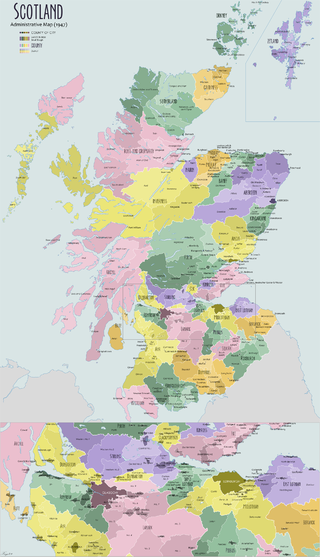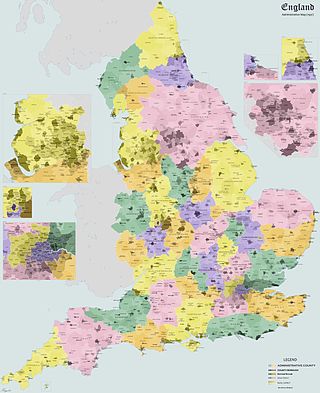The report
The commission published its report on 25 September 1969. In the report it was recognised that were four levels of community in Scotland: [2]
- The region
- The district or shire
- The locality (of which there were 100 to 150)
- The parish (of which there were about 800)
Division of functions
The majority of the commissioners, as expected, recommended a two-tier structure, split between the regional and district level. However, they also suggested that the locality and parish levels could be given a "voice". This would be done by regional authorities choosing to establish "local committees" and by the creation of non-statutory community councils where there was demand. Community councils might be permitted to operate some local services on an agency basis on behalf of district or regional councils. [11]
Regions were to have powers over major planning, social services, housing, police and education; districts over local planning, planning applications, building control, libraries and licensing. [2] [11]
Membership and finance
All members of the proposed councils were to be directly elected, with a four-year term of office. It would be permissible to be a member of both a regional and district council, but an employee of the authority would be ineligible for election. There was to be no upper age limit for candidates. Elections were to be held every two years at either the regional or district level. Councillors were to receive payment for their services, as it was felt that local representatives often made considerable financial sacrifices, and there was no allowance for secretarial or administration costs. Both levels of council were to levy taxes to fund their activities, as this would make them more directly accountable to their electorates. [11]
Local government areas
The report divided Scotland into seven regions, subdivided into thirty-seven districts. They are described in the table below in terms of the existing counties and counties of cities. [2]

| Region | Existing counties and counties of cities | Districts |
|---|---|---|
Central |
| 1. Areas from Perthshire and Stirlingshire |
| 2. Areas from Clackmannanshire, Fife and West Lothian | ||
| East |
| 3. Dundee and surrounding areas including Longforgan from Perthshire, Monifieth from Angus, Newport on Tay and Tayport from Fife |
| 4. Angus (except areas in Dundee district), area from Kincardineshire | ||
| 5. Area from Fife (except areas in Dundee district) | ||
| 6. Kinross-shire and area from Perthshire | ||
| Highlands and Islands |
| 7. Caithness and north east Sutherland |
| 8. Most of Sutherland and Tain area of Ross and Cromarty | ||
| 9. Most of mainland Ross and Cromarty | ||
| 10. Western Isles | ||
| 11. Lochaber area of Inverness-shire, Isle of Skye, north west Argyll | ||
| 12. Southern and western Argyll | ||
| 13. Nairnshire, east Inverness-shire, southern Moray, southern Banffshire | ||
| 14. Orkney and Shetland | ||
| North East |
| 15. City of Aberdeen and adjoining areas of Aberdeenshire and Kincardineshire |
| 16. Eastern Banffshire and north west Aberdeenshire | ||
| 17. Moray and western Banffshire | ||
| 18. Central and southern Aberdeenshire, northern Kincardineshire | ||
| South East |
| 19. Berwickshire, Peebles-shire, Roxburghshire (less areas in South West region), Herot and sow area of Midlothian |
| 20. East Lothian and most of Midlothian | ||
| 21. City of Edinburgh and surrounding areas of Midlothian and West Lothian | ||
| 22. West Lothian | ||
| 23. Part of Fife centred on Dunfermline | ||
| 24. Part of Fife centred on Kirkcaldy | ||
| South West |
| 25. Wigtownshire |
| 26. Dumfriesshire, Kirkcudbright, part of Roxburghshire | ||
| West |
| 27. Southern Ayrshire |
| 28. Northern Ayrshire, part of Lanarkshire (Hamilton and East Kilbride areas) and part of Bute (Isle of Arran and Isle of Cumbrae) | ||
| 29. Part of Argyllshire (Cowal) and Part of Bute (Isle of Bute) | ||
| 30. Southern Lanarkshire including Biggar and Lanark | ||
| 31. Part of Lanarkshire around Motherwell | ||
| 32. Western Dunbartonshire | ||
| 33. Western Renfrewshire including Greenock and Port Glasgow | ||
| 34. Part of Lanarkshire around Coatbridge | ||
| 35. Part of Dunbartonshire (Cumbernauld area), part of Stirlingshire (Kilsyth area) | ||
| 36. Most of Renfrewshire | ||
| 37. Glasgow and surrounding areas of Dunbartonshire, Lanarkshire and Renfrewshire including Bearsden, Clydebank, Bishopbriggs and Rutherglen |
Minority report
Two members of the commission (Anderson and Johnston) dissented on the number of districts that should be created and on the division of powers, feeling that local planning should be a regional function and that the second tier should be formed at the "locality" level with as many as 101 authorities.
They also felt that Shetland, Orkney and the Western Isles should have a special status between that of region and district. [2] [12]










